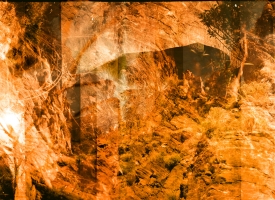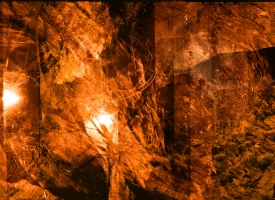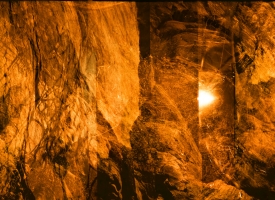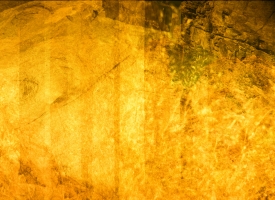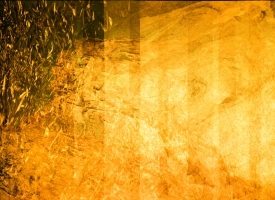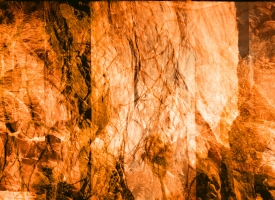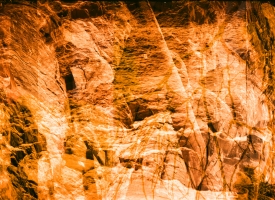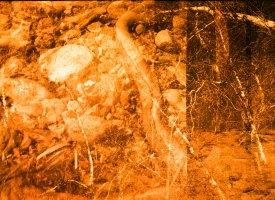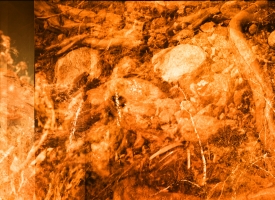SCORPIONS
Project Description
Quintan Ana Wikswo’s SCORPIONS is part of an ongoing body of work, OUT HERE DEATH IS NO BIG DEAL, that addresses the lives of women navigating the tangle of institutional and personal violence in the desert borderlands between Mexico, the Tohono O’Odham Nation, and the southwest United States. SCORPIONS is the artist’s revisitation of all the sites and circumstances in which she was stung by scorpions and (so far) survived. In the desert, there are thousands of different kinds of scorpions. It’s not simply a question of knowing which scorpion you’re dealing with – one must also need to know how to deal with that scorpion.
Artist Statement
My first experience with a scorpion was when it was contained in a dusty bottle of mescal. It seemed as ancient and unlikely as a dinosaur, and I felt both fear and kinship. Since that time, I have known many scorpions, some of which have stung me. Typically, one remembers an encounter with a scorpion because as soon as a scorpion appears, everything changes. Even the light.
Visual Art
All photographs were created on Cahuilla Indian reservations of the Los Coyotes Reservation, the Agua Caliente Band, the Mission Creek Reservation, and others. The photos were made using salvaged 120mm film cameras manufactured by Kodak in the United States. The colors, textures, shapes and multiple layers within the photographs are all created using only the unique aberrations of the cameras’ optics, and the chemistry of the film. The orange and red color occur because of manipulations in the photo-emulsions. There is no software or computer manipulation in the images.
THUMBNAIL GALLERY BELOW. CLICK TO VIEW FULL-SIZE PANORAMIC IMAGES.
Literature
EXCERPT
SCORPIONS
by Quintan Ana Wikswo
It’s a bright moon night in Ciudad Juarez and the girl gets out of Marisa’s bed after sex and walks barefoot to the bathroom and she steps on a stick. Some kind of crazy painful kind of stick.
Downstairs, Octavio says there’s nothing to be done about it. He calls the woman from around the corner, she’s a nurse, and she arrives with an old gold electroplate stopwatch. Octavio and the nurse sit next to the girl, with the tiny golden hand clicking round and round in its glass orb and Octavio’s sister Marisa brings down the black scorpion in a jar. It’s a twist of wire. Thirsty. It’s a knife machine.
Marisa says, if she’s really a bruja, this won’t kill her.
The scorpion is dead. She pours last night’s mescal in the jar and sits it on a shelf with the others, for good luck. For everything good, mescal. And for everything bad, as well.
Octavio says, if it kills her, it’s no big deal. He shrugs.
In Mexico, he says to her, death is no big deal.
Octavio and the girl used to get it on, fast and black and low down, they were bugs skittering from the light at night. He’s like a father to her. He’s the one always left standing. He’s the man who survives the end of time. He looks down at the watch.
The watch is ticking close to the eleven minute mark, which is how long it takes a witch to die of a Sonoran black scorpion sting.
Octavio says, our mother had twelve children, but only the two of us lived.
He wraps the girl’s hair around his index finger and tugs.
He says, You will meet the rest of our sisters and my brothers soon.
He says, Death will be a great place for you. You’ll like it better over there. You’ll be reborn. My family will greet you with firecrackers. And food.
Marisa says, they will greet her with a crucifix and an axe.
Perhaps, Octavio says, perhaps with a little of everything.
They look at the girl and then they look at the stopwatch.
Ten and a half minutes, they say.
You’ll be fine, they say. Either way, they say. You’ll see.
Published in Performed at Le Poisson Rouge, May 2013
Credits
SCORPIONS has been performed in New York City with Flashpoint/NYC ensemble at (Le) Poisson Rouge. It has also been performed for scorpions in the Sonoran Desert.


